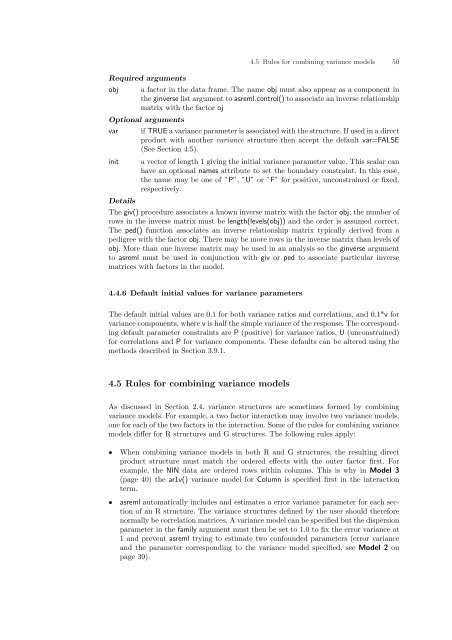ASReml-S reference manual - VSN International
ASReml-S reference manual - VSN International
ASReml-S reference manual - VSN International
- No tags were found...
Create successful ePaper yourself
Turn your PDF publications into a flip-book with our unique Google optimized e-Paper software.
Required argumentsobj4.5 Rules for combining variance models 50a factor in the data frame. The name obj must also appear as a component inthe ginverse list argument to asreml.control() to associate an inverse relationshipmatrix with the factor ojOptional argumentsvarinitDetailsif TRUE a variance parameter is associated with the structure. If used in a directproduct with another variance structure then accept the default var=FALSE(See Section 4.5).a vector of length 1 giving the initial variance parameter value. This scalar canhave an optional names attribute to set the boundary constraint. In this case,the name may be one of ”P”, ”U” or ”F” for positive, unconstrained or fixed,respectively.The giv() procedure associates a known inverse matrix with the factor obj; the number ofrows in the inverse matrix must be length(levels(obj)) and the order is assumed correct.The ped() function associates an inverse relationship matrix typically derived from apedigree with the factor obj. There may be more rows in the inverse matrix than levels ofobj. More than one inverse matrix may be used in an analysis so the ginverse argumentto asreml must be used in conjunction with giv or ped to associate particular inversematrices with factors in the model.4.4.6 Default initial values for variance parametersThe default initial values are 0.1 for both variance ratios and correlations, and 0.1*v forvariance components, where v is half the simple variance of the response. The correspondingdefault parameter constraints are P (positive) for variance ratios, U (unconstrained)for correlations and P for variance components. These defaults can be altered using themethods described in Section 3.9.1.4.5 Rules for combining variance modelsAs discussed in Section 2.4, variance structures are sometimes formed by combiningvariance models. For example, a two factor interaction may involve two variance models,one for each of the two factors in the interaction. Some of the rules for combining variancemodels differ for R structures and G structures. The following rules apply:• When combining variance models in both R and G structures, the resulting directproduct structure must match the ordered effects with the outer factor first. Forexample, the NIN data are ordered rows within columns. This is why in Model 3(page 40) the ar1v() variance model for Column is specified first in the interactionterm.• asreml automatically includes and estimates a error variance parameter for each sectionof an R structure. The variance structures defined by the user should thereforenormally be correlation matrices. A variance model can be specified but the dispersionparameter in the family argument must then be set to 1.0 to fix the error variance at1 and prevent asreml trying to estimate two confounded parameters (error varianceand the parameter corresponding to the variance model specified, see Model 2 onpage 39).
















